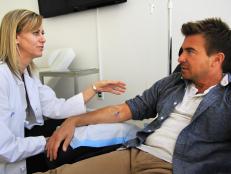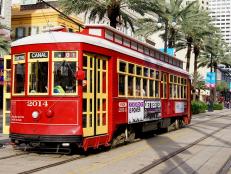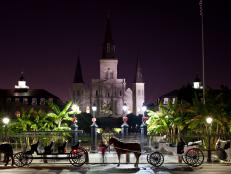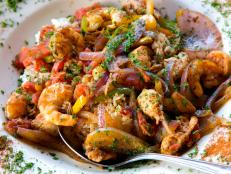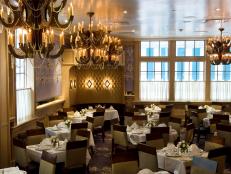11 Under-the-Radar Galleries, Distilleries and Secret Finds in New Orleans
From world-class new eateries to modern iterations of historic traditions, we’ve mapped out the tastiest, newest and most curious Crescent City destinations.

Related To:
lessRelated To:
Party City
New Orleans has a well-deserved reputation for encouraging visitors to laissez les bon temps rouler, thanks to its festivals for every occasion, world-class music and culinary scenes and relaxed attitude toward revelers who want to let their hair down, so to speak. It's also the ideal place to step away from the throngs and meet historians, cultural curators and innovators who'll upend what you think you know about the Big Easy. The city you'll meet at these 11 stops is ready for its close-up.
The Old No. 77 Hotel & Chandlery
Housed in a 215-year-old former coffee warehouse, The Old No. 77 is a 10-minute walk from the French Quarter (read: easy access to downtown revelry and a comfortable escape from the crowds when you’re ready for the good times to stop rolling for the night). It’s also a mainstay of the vibrant Gallery District, and its labyrinthine halls serve as a satellite space for rotating exhibitions from Where Y’Art, a pioneering brick-and-mortar and online gallery that showcases projects from more than 100 New Orleans artists. The hotel prides itself on signature events like this summer’s Camp NOLA, a series of programs that introduces visitors to local craftspeople, musicians and personalities, and its lobby is a reliable place to rub shoulders with the city’s most creative residents.
Killer Po' Boys
As one oft-repeated story goes, New Orleans’s celebrated sandwich came together in 1929 (when Clovis and Benjamin Martin began serving meat scraps and gravy on French bread to striking streetcar workers). Eighty-odd years later, Cam Boudreaux and April Bellow began slinging 21st-century takes on the classic from the back of the Erin Rose, a Conti Street watering hole half a block from Bourbon Street. They’ve doubled down with Big Killer PoBoys, a full-fledged sister shop at 219 Dauphine that fills bellies with everything from black beer beef debris, cheddar omelet, smoked salmon and veggie-friendly roasted sweet potato po' boys to roasted cauliflower and whiskey grilled cheese sandwiches, along with a selection of local craft beers, spiked teas, mimosas and more.
Seven Three Distilling
“From music, food [and] drink [to] ever increasing spirits, New Orleans is part of a culture that embraces its history while continuing to experiment,” says Erik Morningstar of Seven Three Distilling, a small-batch distillery, tasting room and cocktail bar. “All of the spirits coming out of New Orleans are made from the bounty of our local agriculture and continue the traditions of old, but we don't hesitate to improvise when the opportunity arises." The Seven Three team is committed to celebrating the city it calls home, and each of its spirits takes its name from one of NOLA’s 73 neighborhoods. A tour of the premises is much more than a crash course in distillation; you’ll leave with a fire in your belly and a head full of New Orleans lore.
Voodoo Queen Kalindah Laveaux
New Orleans Voodoo Queen Kalindah Laveaux is committed to sharing her spiritual traditions with visitors to the city — and to dispelling all-too-common misconceptions about it. To that end, Kalindah provides readings and ritual experiences (such as sacred song and dance, drumming and blessings) during special events at the Old No. 77 Hotel. "It's important for me to share this information about New Orleans and Louisiana Voodoo because, first of all, it's important to understand Voodoo in the context of the people who brought the tradition here from Africa; we are the creators of that culture," says Kalindah. "It's common to disrespect and ridicule it, and to use it where it's not applicable; my work is to right that wrong." She also offers private sessions, workshops and customized introductions to Louisiana's Voodoo and Afro-Creole culture — each of which is an eloquent rejection of pop-culture stereotypes.
The Franklin
Fans of The Franklin — a Marigny eatery that became a neighborhood favorite over its four years in a corner grocer’s berth at Dauphine Street and Franklin Avenue — were left with broken hearts and grumbling stomachs when it closed its doors for a revamp in 2018. As of mid-2019, it’s back as a gastrobar with a new team led by executive chef Dane Harris, a daring cocktail menu (designed by heavy-hitting mixologists Evan Wolf of The Company Burger, Matt LoFink of Cure and Jason Sorbet of Barrel Proof) and a rotating selection of contemporary art curated by New Orleans-based collector Michael Wilkinson. The Franklin 2.0 is “more casual, more approachable and a little more affordable,” according to its managing partner. In other words, it’s more than ready to make new friends (and the eclectic dinner menu has something for everyone).
Hové Parfumeur
When the proprietors of Hové (which has scented the city’s denizens since 1931 and is rumored to have been the inspiration for the shop in Tom Robbins’s Jitterbug Perfume) call their fragrant establishment a multigenerational labor of love, they aren’t just talking about themselves. They have customers who bring their daughters to select signature fragrances on their 18th birthdays because their mothers made the same pilgrimage with them. The charming Chartres Street shop now offers 52 scents in a variety of colognes, perfumes and oils — and if you’d like to bring a bit of old New Orleans back to your home, you’ll have your pick of room sprays, candles and wax tarts with notes of Spanish moss, tea olive and vetivert (the preferred scent of Creole aristocrats, also available in Louisiana-grown root form).
Confederacy of Cruisers
Jeff Shyman launched the city’s first bicycle tour 11 years ago because it was, quite simply, the kind of tour he wanted to take. The laid-back, ultra-personalized excursions he and his team have developed give visitors glimpses (and sips and tastes) of New Orleans that simply wouldn’t be possible on large, plug-and-play outings. An $89 four-hour Confederacy of Cruisers culinary trip (reserved in advance via the group’s website) includes old-school wheels, all food and tips, and a one-of-a-kind account of what Jeff calls the “300-year potluck” that is his adopted city. Note that while you will certainly pedal all over town, you won’t come anywhere close to burning off the calories you’ll consume. CoC isn’t fooling around when it comes to feeding you.
Faulkner House Books
Some say Pirate’s Alley — a single block between Chartres Street and Royal Street in the French Quarter — helped swashbuckling visitors gain access to the city via the Mississippi River. Others call it one of the most haunted locations in New Orleans. We can say with certainty that it played host to William Faulkner, who penned his first novel there as a boarding-house tenant in 1925. You can purchase a copy of that novel (Soldiers’ Pay) in the very spot where he wrote it, as 624 Pirate’s Alley is now Faulkner House Books, a national literary landmark that’s recognized by bibliophiles around the world as one of the most charming bookstores in America. The shop specializes in Faulkner’s work, of course, as well as modern first editions and Southern writers (with an emphasis on regionally-significant titles).
Gianna
To the casual observer, Gianna seems to be of a piece with its artsy Warehouse District neighbors — its gleaming surfaces and custom installations would be right at home at the galleries down the street. Close your eyes and take a bite of one of Executive Chef Rebecca Wilcomb’s rustic Italian dishes, however, and you’ll find yourself at her grandmother’s table in the Veneto. With foraged and farmed Southern produce (sourced within 250 miles of New Orleans) paired with Gulf seafood and house-made pasta, the James-Beard-Foundation-award-winning Wilcomb celebrates both Louisiana techniques and traditions she inherited at family meals.
Boutique du Vampyre
The New Orleans Vampire Association (NOVA) notes that the city “has always been home to legends of nonhuman sentient beings living alongside and among humans.” If and how those beings mingle with mortal tourists is a subject of spirited debate, as it were, but there’s no denying the dark allure of St. Ann Street’s Boutique du Vampyre, a one-stop shop and library with goodies like handcrafted jewelry and décor, custom fangs and gourmet gothic treats. Strike up a conversation at the counter to receive an invitation and directions to the proprietor’s vampire speakeasy (because of course New Orleans boasts a vampire speakeasy). Fair warning: Per a framed notice in the restroom, there is to be “ABSOLUTELY NO SHAPE SHIFTING ON THE BALCONY[.]”
Compère Lapin
Jordan Deis, the newly-appointed head of the cocktail program at Compère Lapin, is shaking up the mixology menu at what is routinely recognized as one of the best bars in the country. Fortify yourself for a Warehouse District art crawl with Deis’s ingenious Ramos Gin Freeze (a blended update on a classic sip with gin, citrus, orange blossom and oats) or a Penultimate Oath (his riff on The Last Word, made with Sotol, Túnel de Mallorca and a cucumber-and-citrus granita). Compère Lapin continues to accumulate laurels for its cuisine as well: Chef Nina Compton received the James Beard Foundation’s Best Chef: South award last year, and she serves up awe-inspiring Caribbean-influenced fare (she’s a St. Lucia native) that showcases her continental training.
